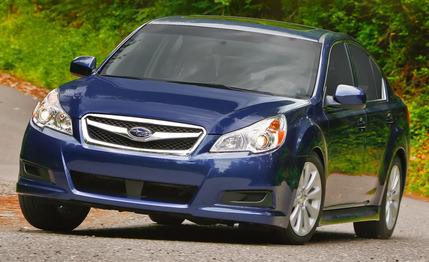
 First Drive Review
First Drive Review
The previous-generation Legacy was a great driver’s car, especially within the family-sedan market. Standard all-wheel drive offered all-weather security and the chassis felt lively, but the car suffered from weak fuel economy and a tight back seat. Indeed, the shortcomings made it seem as though Legacy buyers were making a sacrifice simply by purchasing the car, opting to join a secret Subie society instead of purchasing a more sensible, practical model from another manufacturer.
The new, fifth-generation Legacy retains Subaru’s now-trademark all-wheel drive but is larger than its predecessor by every measure of the tape. We won’t bore you with all the dimension changes, but noteworthy is the 3.2-inch stretch in wheelbase (now 108.3 inches) with only a 1.4-inch bump in overall length (now 186.4).
Surprisingly Good CVT
The same 170-hp flat-four that powered the previous Legacy carries over as the base engine in the 2.5i. In the latest car it couples with a new six-speed manual or a new CVT. Although the six-speed’s sloppy shifter disappointed us—blame cable-actuated shift linkages versus the old rod-actuated type, says Subaru—the CVT surprised us. It manages to keep the revs low when cruising and the droning, golf-cart-style acceleration typically associated with a CVT to a minimum. Also, according to the onboard fuel consumption gauge, the CVT delivers on Subaru’s 31-mpg highway claim (the CVT is rated at 23 in the city). The CVT also has a manumatic feature that allows for the selection of dedicated ratios via steering-wheel-mounted paddles. We consider fake “gears” to be a bit hokey, but they are handy when descending a steep grade, as the transmission will do some of the braking for you.
Few of you might remember, but this is not Subie’s first attempt at a CVT. The 1987 Justy featured one, but it was poorly received by U.S. consumers. Subaru claims this new CVT, dubbed Lineartronic, is extremely durable and that the fluid will never need to be changed over the life of the transmission.
Powering the Legacy 2.5GT is a turbocharged 2.5-liter flat-four similar to the one that powers the Impreza WRX. This engine makes the same 265 hp as the WRX but does so using a different turbocharger and a reworked exhaust manifold. A six-speed manual—the same box as in the 2.5i model but with different ratios—is the only transmission for the GT. Even if the gearbox itself is a bit disappointing in use, it’s refreshing that Subaru execs made this decision. They believe enthusiast-oriented GT buyers would shun a slushbox. The $25,690 R model upgrades from a 3.0-liter flat-six to a 3.6-liter flat-six making 256 hp. A five-speed automatic is the only transmission available in the R.
Diesel on the Way?
Subaru has confirmed that it has a turbo-diesel in the works for North America but will not confirm what cars or SUVs will be touched by its torquetastic presence. Our guess is that it will definitely find its way into the granola-hauling Outback and Forester. We’re unsure whether or not the diesel will power this fifth-generation Legacy.
Beneath the new body—its strongest design statement is made by the squared-off fender arches—is a new chassis, although it does borrow some suspension components from the Impreza/Forester platform. With a strut-type suspension in front and control arms out back, the Legacy proved to be a smooth cruiser on the highway and a capable back-road bomber, despite a healthy amount of body roll. To be fair, our drive route featured some of the smoothest pavement in North America, and the roads weren’t squiggly like the Stelvio Pass. Even so, this Legacy will hustle down a two-lane at least as quickly as a Mazda 6 or Honda Accord, if not quicker.
We Expect It to Be Quicker, and There’s More Room
We expect the 2.5GT to break the 60-mph mark in about 5.1 seconds, or a 10th or two quicker than the older car. A base 2.5i equipped with the CVT should do the same feat in fewer than eight seconds. So when compared with the current Honda Accord—our reigning mid-size-sedan favorite—the Legacy will be quicker across the board. We expect skidpad numbers for the GT to improve, as it now sports Bridgestone Potenza RE050A performance tires. That footwear stretches around 18-inch wheels and replaces the outgoing car’s all-season Potenza RE92 rubber. The base 2.5i car comes with all-season tires on 16-inch steel wheels; 16- or 17-inch alloys are optional.
Interior space benefits greatly from the wheelbase stretch. Passenger volume grows by 12 cubic feet to 102, with two-thirds of the newfound space apportioned to the rear seats. Subie freed up a little more center-console space through the adoption of an electronic parking brake located in a small panel to the left of the steering wheel. The back seat boasts excellent thigh support and plenty of head- and legroom, even for folks in the six-foot-five range. Being bigger, the new Legacy is heavier. Subaru claims a 65-pound weight gain, and the range now tops out at 3600 pounds.
Sales should begin this August. The 2.5GT, our favorite, will start at $28,690. A base 2.5i with the CVT starts at $21,690, undercutting the less efficient, front-wheel-drive Honda Accord LX by $725. So Subaru has created a larger, more competitive—and still fun to drive—Legacy that has a base price lower than that of the current class favorite. Doesn’t really sound like much of a sacrifice anymore, does it?